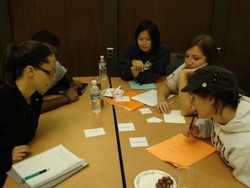2016 Annotated Bibliograpy of Postsecondary Peer Cooperative Learning Programs Updated

This annotated bibliography does not attempt to be inclusive of this broad field of literature concerning peer collaborative learning. Instead, it is focused intentionally on a subset of the educational practice that shares a common focus with increasing student academic achievement and persistence towards graduation.
The seven student peer learning programs included in this bibliography meet the following characteristics: (a) the program must have been implemented at the postsecondary or tertiary level; (b) the program has a clear set of systematic procedures for its implementation that could be replicated by another institution; (c) program evaluation studies have been conducted and are available for review; (d) the program intentionally embeds learning strategy practice along with review of the academic content material; (e) the program outcomes include increased content knowledge, higher final course grades, higher pass rates, and higher college persistence rates; and (f) the program has been replicated at another institution with similar positive student outcomes. From a review of the professional literature, six programs emerged: (a) Accelerated Learning Groups (ALGs), (b) Emerging Scholars Program (ESP), (c) Peer Assisted Learning (PAL), (d) Peer-Led Team Learning (PLTL), (e) Structured Learning Assistance (SLA), (f) Supplemental Instruction (SI), and (g) Video-based Supplemental Instruction (VSI). As will be described in the following narrative, some of the programs share common history and seek to improve upon previous practices.Other programs were developed independently.
Regrets for scholarship I have overlooked. Please send me items you think should be included in the next edition. Happy reading.
